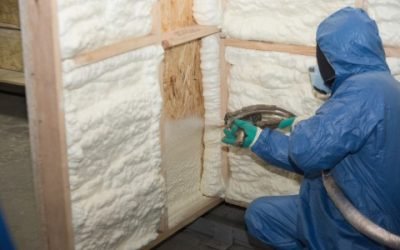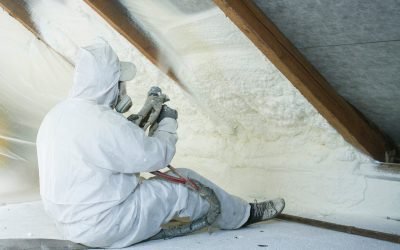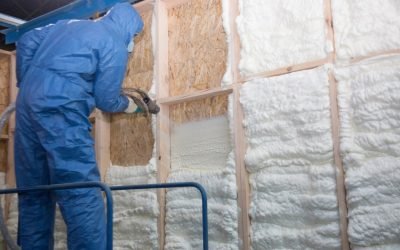Spray Foam Insulation for Attics
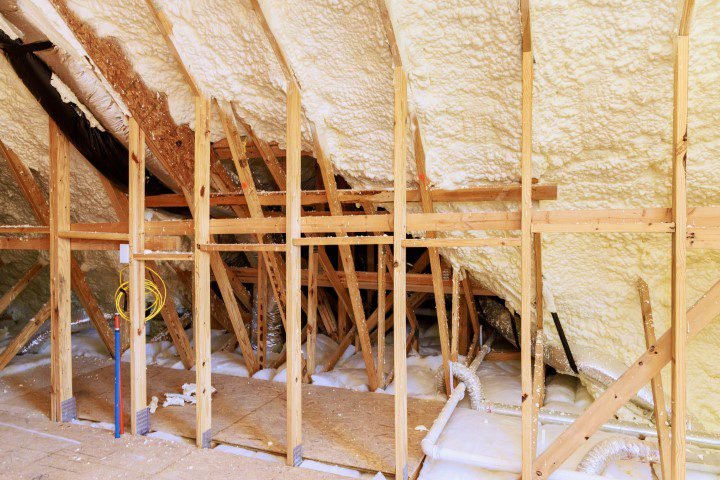
Last Updated on June 18, 2024 by Spray Foam Insulation Plus
Spray foam insulation is a smart choice for your attic because it expands to fill all spaces, making an air seal that prevents unwanted energy loss. This not only keeps your home warm during cold seasons but cool during hot ones. Unlike other insulation types, spray foam creates a moisture barrier protecting your attic from outdoor temperature changes and air infiltration. Applying this material needs a skilled hand for even distribution and correct thickness. The difference you’ll notice next is in your energy bills, padded with savings from your well-insulated attic. Now let’s explore more on this effective insulator.
Spray foam insulation is an excellent choice for attics as it provides a seamless, airtight seal that helps prevent air leakage, reduces heat transfer, and effectively insulates hard-to-reach or irregular spaces. This ensures improved energy efficiency, lower utility bills, and enhanced overall comfort within the home.
Spray Foam Insulation for Attics Explained
The attic can be a neglected but crucial part of your home when it comes to insulation. Spray foam insulation is an effective solution for sealing off the attic from outdoor temperature fluctuations, moisture, and air infiltration. When applied properly, it creates a seamless layer of protection against the elements.
Unlike traditional insulation materials like fiberglass or cellulose, spray foam insulation isn’t placed between joists or rafters. Instead, it involves the application of a specialized material that expands to fill gaps and voids, creating an effective air seal to prevent energy loss. This is important because gaps and leaks in attic spaces are often the major contributors to heat loss, which can lead to increased energy bills and reduced comfort.
Imagine your attic as the boundary between your home and the outside world. Without proper insulation, it would be like having cracks around windows and doors – you’d be losing heat in winter and letting it in during summer while also exposing your home to moisture and pests. Spray foam insulation acts as the ultimate barrier, sealing off your attic from these issues by filling every nook and cranny with a durable layer of protection.
What’s more, spray foam provides superior thermal resistance, helping regulate indoor temperatures regardless of the weather outside. This means your heating and cooling systems don’t have to work overtime to keep your living spaces comfortable throughout the year.
Emphasizing professional installation is key to ensuring that the insulation is applied evenly and to the proper thickness for optimal performance. It’s not just about spraying foam; it’s about understanding the science behind it and expertly applying it to create a well-insulated attic space.
Professional installation is similar to having a skilled artist paint your home—they know just how much paint to apply for even coverage without wasting any material or leaving any spots bare. In the same way, professional installers understand how much spray foam is needed to create a uniform barrier that maximizes energy efficiency and protects your home from environmental factors.
In summary, spray foam insulation for attics is not just about keeping your attic warm or cool – it’s about keeping your entire home protected from the elements and ensuring long-term energy efficiency and comfort.
In the quest for a well-insulated home, understanding the significant advantages of foam insulation goes beyond just keeping energy bills in check. Let’s now explore how this innovative approach can be a game-changer for homeowners looking to fortify their properties against external elements.
Call us today to schedule your attic insulation installation at 612-730-9417
Key Advantages of Foam Insulation
When it comes to insulating your attic, spray foam insulation offers several advantages that extend beyond simply keeping your home warm in the winter and cool in the summer. Let’s explore these benefits and why they are so significant.
Improving Energy Efficiency
By maintaining consistent indoor temperatures, spray foam insulation significantly reduces energy consumption. This results in lower heating and cooling costs, making it an environmentally friendly choice. Unlike traditional insulation methods, spray foam minimizes air leakage and heat transfer, effectively reducing the workload on HVAC systems. The impact? A more comfortable home without the hefty energy bills.
Creating an Airtight Barrier
One of the standout features of spray foam is its ability to create an airtight barrier. In the attic, an area prone to temperature variations and air infiltration, this is crucial. By sealing small cracks and gaps with precision, foam insulation prevents drafts and heat loss, ensuring that your home maintains a consistent and comfortable temperature year-round.
Just imagine – no more chilly drafts or hot spots in your living spaces!
Controlling Moisture Buildup
Aside from temperature control, moisture buildup is a major concern in attics. The impermeable nature of spray foam is a game-changer here. By creating a moisture barrier, it helps prevent the risk of mold, mildew, and structural damage caused by excess humidity. These moisture-related issues can be costly to repair, making foam insulation a proactive solution for long-term home maintenance.
Ensuring Longevity
While initial installation costs might be a consideration for some homeowners, it’s important to remember that properly installed spray foam insulation can have a long lifespan. This means not only guaranteed sustainable energy efficiency benefits over an extended period but also fewer maintenance costs associated with replacing worn-out or ineffective insulation materials.
Embracing spray foam insulation is an investment in the long-term comfort, energy efficiency, and structural integrity of your home. These key advantages make the case for choosing spray foam insulation as a smart choice for attics undeniable.
Detailed Guide to Insulation Installation
The installation process for spray foam insulation begins with a comprehensive pre-installation inspection. Professionals meticulously assess the attic to identify any existing issues and determine the precise amount of insulation required for optimal performance.
During this inspection, professionals look for signs of moisture or damage that may need addressing prior to the application of insulation. Additionally, they calculate the R-value needed to meet energy efficiency standards and ensure even application across the attic surface.
The next crucial phase involves the application process. Trained installers use specialized equipment to evenly distribute the spray foam insulation material across the entire attic surface, including hard-to-reach areas and gaps. This effectively seals off potential air leaks and heat transfer points, ensuring thorough insulation coverage.
Safety measures are integral to the installation process. Installers wear protective gear, including masks, gloves, and coveralls, to shield themselves from the insulation material. It’s also crucial for anyone in the vicinity to vacate the area during the application to avoid exposure. Proper ventilation during and after installation is key to maintaining a safe environment.
Once the insulation has been applied, a post-installation assessment is carried out to confirm uniform distribution and desired performance standards. This may involve using infrared cameras to identify any missed spots or uneven application, ensuring intended energy efficiency and temperature regulation benefits are fully realized.
In summary, every step in this detailed guide, from pre-installation inspection to safety measures and post-installation assessment, plays a crucial role in ensuring effective insulation with spray foam in your attic.
With a well-insulated attic setting the stage for enhanced energy efficiency, let’s now explore how embracing spray foam can further amplify these advantages.
Boosting Energy Efficiency with Spray Foam
Spray foam insulation doesn’t just create a barrier against outdoor weather – it actively teams up with your attic to keep energy use in check. By sealing off gaps and cracks, it minimizes heat transfer and maintains a comfortable indoor temperature. When you have gaps and holes in your attic, warm or cool air can sneak out, making your heating and cooling systems work extra hard to keep your home cozy. But once these voids are properly sealed with spray foam insulation, your home stays at the right temperature for longer periods, which means less pressure on your heating and cooling systems.
Unlike traditional insulation materials like fiberglass, spray foam sticks to any surface it touches. This means it forms an effective air barrier, keeping conditioned air inside your living spaces while preventing unconditioned air from creeping in. As a result, your HVAC system doesn’t have to work as hard to maintain a consistent temperature.
Impact on Energy Savings
The direct impact on energy savings is remarkable. By reducing the load on your heating and cooling systems, spray foam insulation helps lower your utility bills over time. With reduced strain on these systems, their lifespans increase, leading to potential cost savings through fewer repairs or replacements.
In the scorching summer months or freezing winters, the wrong insulation might struggle to maintain a comfortable temperature in your living space. However, spray foam insulation creates an efficient barrier against outdoor temperatures (Home Energy Guide from the Minnesota Commerce Department), and you’ll notice more stable temperatures indoors around the clock.
Comfort in Your Living Space
But it doesn’t end there – the comfort it brings to your home deserves special mention! Just imagine walking in from the sweltering heat or biting cold outside, only to find your home feeling consistently comfortable throughout. No more battling with uneven room temperatures or hot spots near windows during summer; spray foam has got you covered! Moreover, by reducing the infiltration of outdoor air into your living space, spray foam insulation can also improve indoor air quality. Less dust and allergens from outdoors seeping in means cleaner air inside.
In summary, the installation of spray foam insulation in attics vastly improves energy efficiency by effectively minimizing heat transfer, resulting in significant cost savings and overall comfort within the home.
As we’ve explored how spray foam insulation enriches energy efficiency and enhances comfort in homes, the next logical step is understanding the critical role of R-Value in evaluating insulation effectiveness.
The Relevance of R-Value
R-value is a vital concept in insulation, including spray foam insulation. Essentially, R-value measures a material’s ability to resist heat flow. So, the higher the R-value, the more effective the insulation is at preventing heat from escaping or entering your home.
Imagine your attic as a shield that guards your home against extreme temperatures. In the summer months, it acts as a barrier to prevent outdoor heat from making its way inside, and in winter, it helps to keep the warmth produced by your heating system from escaping. This is where the R-value becomes crucial. A high R-value means your shield is stronger and better at keeping unwanted temperatures at bay and maintaining the desired climate inside your living space.
To put things into perspective, different climates require different levels of R-value for optimal insulation. For example, an attic in a region with harsh winters, such as Minnesota, will need a higher R-value than an attic in a milder climate. A professional insulation installer can assess local climate conditions and recommend the most suitable R-value for your attic.
It’s worth noting that specific building codes often stipulate minimum R-values for attics in different areas, so consulting with a professional can provide insights and ensure compliance with regulations.
Let’s take this a step further – think about how you dress in different weather. You wouldn’t wear a light jacket in freezing weather or a heavy coat in warm weather; similarly, choosing the right R-value for your attic insulation depends on the climate it’s facing. Just like you might layer up during bitter cold days to keep warm, ensuring your attic has the right R-value layers it up against extreme temperatures outside.
For example, attics in colder climates like Minnesota would benefit from a recommended R-value of 49. On the other hand, attics in warmer climates may require around an R-value of 30. Remember that these figures are just examples, and professional installers can recommend the optimal R-value based on specific climate conditions in your area.
Understanding how R-value plays a fundamental role in insulation effectiveness equips homeowners with valuable knowledge when considering their climate’s unique requirements. Consulting professional installers ensures that you’re getting the right level of protection for your home based on your location’s specific climate conditions.
Cost and Noise Reduction with Foam Insulation
Spray foam insulation may have a higher upfront cost compared to traditional options, but it’s crucial to focus on its long-term cost efficiency. Its superior ability to create an airtight seal results in significant energy savings and reduced usage of heating, ventilation, and air conditioning (HVAC) systems. This means that while the initial investment is slightly higher, the long-term benefits are substantial. It’s like investing in a high-quality tool – you pay more for it at the start but end up saving so much more in the long run due to its superior performance and durability.
When it comes to understanding the cost-saving benefits of spray foam insulation, R-value plays a significant role. While the R-value measures thermal resistance, which determines how well the insulation can resist heat transfer, it also has an impact on energy costs. The higher the R-value, the greater the insulating power. Spray foam insulation’s high R-value makes it extremely effective in reducing energy bills over time by keeping indoor temperatures stable.
Apart from being cost-efficient, spray foam insulation also offers an additional benefit: noise reduction. It acts as a sound barrier, minimizing the infiltration of outdoor noises into your home. This is especially valuable if you live in a bustling, urban area or near noisy neighbors. The attic is often an overlooked space when it comes to noise control, but properly insulated with spray foam, it can contribute to a quieter and more peaceful indoor environment. It essentially enhances your overall comfort at home by reducing unwanted noise levels.
Imagine enjoying a peaceful evening at home without street noises seeping through your walls or hearing every passing car outside – that’s what a well-insulated attic offers. It’s like having your home wrapped in a cozy blanket that keeps you warm and quiet.
Further demonstrating cost efficiency, less dependence on artificial heating and cooling due to spray foam insulation’s energy-saving capabilities means fewer maintenance requirements and lower energy bills over time. In regions with extreme temperature fluctuations, this level of insulation ensures that internal climate control is maintained effectively without relying heavily on HVAC systems.
So, not only does spray foam insulation save money in terms of energy efficiency, but it also contributes to a quieter and more comfortable indoor environment by reducing noise infiltration from outside sources. This makes it a smart investment for long-term cost-effectiveness and enhanced living quality.
In conclusion, investing in spray foam insulation for your attic not only promises significant long-term energy savings but also offers the added advantage of creating a quieter and more comfortable living space. Ready to transform your attic space? Contact us today at Spray Foam Insulation Plus or call us at 612-730-9417.
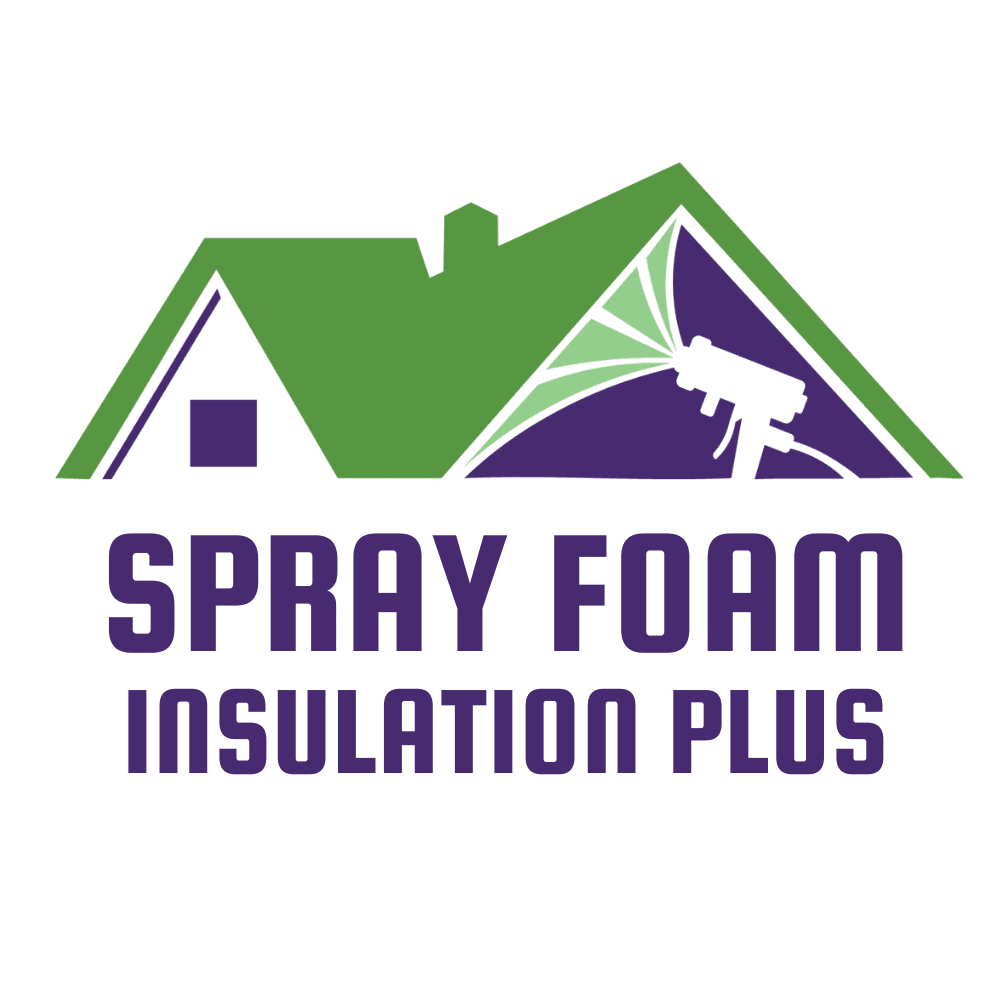
Tags
Preferred Contractors of:

